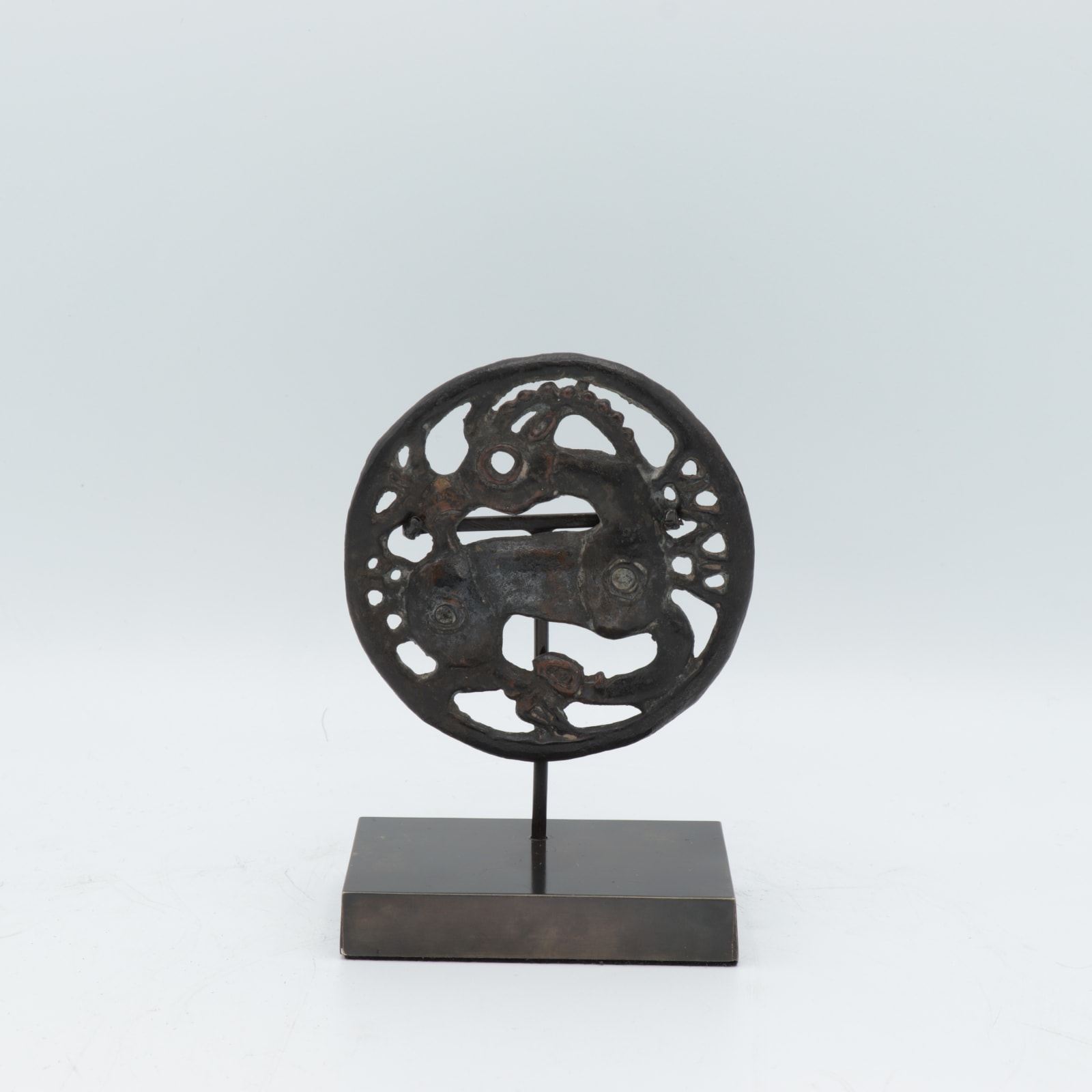Elamite Roundel, 3rd - 1st millennium BCE
Bronze
diameter 8.7 cm
diameter 3 3/8 in
diameter 3 3/8 in
EL.0076
This Elamite roundel depicts a deer. It is seen from the side, with its body facing to the right. Its legs are curved towards each other, meeting at the hooves....
This Elamite roundel depicts a deer. It is seen from the side, with its body facing to the right. Its legs are curved towards each other, meeting at the hooves. This suggests either that the animal is lying down or that it is mid-gallop. Its long neck is bent backwards, looking behind it to the left. There is a large round hole in its face to represent its eye, mirrored by two circles on the front and back of its body. The antler that grows out of the top of its head is connected at the end to its neck, and a small strip of metal connects its face to its back. On either side of its body, branching motifs with holes between them link the edges of the animal to the circular edge. On the back of the roundel there is a projection shaped like the head of a nail. This would perhaps have allowed it to be attached to clothes or equipment.
The Elamite civilisation occupied the west and south-west of modern Iran from around 3200 BC until the mid-first millennium BC, when its capital, Susa, was overtaken by first the Assyrians and then the Persian Achaemenid empire. The proto-Elamite states of Anshan, Awan, and Shimashki are thought to have combined to form Elam. Susa was founded in around 4000 BC, and remained an important city for hundreds of years, including as a strategic centre. During the Old Elamite Period, from c.2700 BC to c.1500 BC, there were three different ruling dynasties. Susa also faced attacks from various other civilisations, including multiple Mesopotamian states and the Guti. The Middle Elamite period, from c.1500 to c.1100 BC, was also characterised by several different dynasties. Towards the end of this period, the Elamite empire reached the height of its power under the Shutrukids. These kings undertook several military campaigns and building projects to increase the strength of the state. Less is known about the Neo-Elamite Period, from c.1100 BC to 540 BC. Again, the state engaged in many battles with surrounding civilisations, and was defeated by the Neo-Assyrians under Ashurbanipal on multiple occasions.
The Elamite civilisation occupied the west and south-west of modern Iran from around 3200 BC until the mid-first millennium BC, when its capital, Susa, was overtaken by first the Assyrians and then the Persian Achaemenid empire. The proto-Elamite states of Anshan, Awan, and Shimashki are thought to have combined to form Elam. Susa was founded in around 4000 BC, and remained an important city for hundreds of years, including as a strategic centre. During the Old Elamite Period, from c.2700 BC to c.1500 BC, there were three different ruling dynasties. Susa also faced attacks from various other civilisations, including multiple Mesopotamian states and the Guti. The Middle Elamite period, from c.1500 to c.1100 BC, was also characterised by several different dynasties. Towards the end of this period, the Elamite empire reached the height of its power under the Shutrukids. These kings undertook several military campaigns and building projects to increase the strength of the state. Less is known about the Neo-Elamite Period, from c.1100 BC to 540 BC. Again, the state engaged in many battles with surrounding civilisations, and was defeated by the Neo-Assyrians under Ashurbanipal on multiple occasions.
